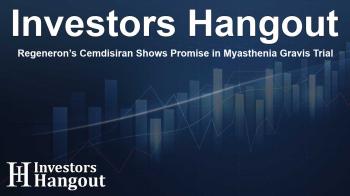Regeneron’s Cemdisiran Shows Promise in Myasthenia Gravis Trial

Regeneron’s Cemdisiran Shows Promise in Myasthenia Gravis Trial
Cemdisiran monotherapy has shown positive results in treating patients with generalized myasthenia gravis, achieving both primary and secondary endpoints in the Phase 3 NIMBLE trial.
Trial Overview and Key Findings
The Phase 3 NIMBLE trial aimed to evaluate cemdisiran, an investigational siRNA therapeutic that targets complement factor 5 (C5). The results indicated a 2.3-point placebo-adjusted improvement in the Myasthenia Gravis Activities of Daily Living (MG-ADL) total score. It's noteworthy that cemdisiran was administered subcutaneously every three months.
Regulatory Submission Plans
Regeneron Pharmaceuticals, Inc. (NASDAQ: REGN) is planning to submit a request for U.S. regulatory approval of cemdisiran in early 2026, following discussions with the FDA. This strategic step comes after a thorough review of the positive trial results.
Details of the NIMBLE Trial
The NIMBLE trial involved adults diagnosed with generalized myasthenia gravis (gMG) who presented with antibodies to the acetylcholine receptor. Over the course of the study, 600 mg of cemdisiran was administered every 12 weeks, with a combined treatment of cemdisiran and pozelimab—administered as cemdi-poze—given every four weeks. The trial emphasized the importance of both the MG-ADL and the Quantitative Myasthenia Gravis (QMG) scores to gauge treatment efficacy.
Results and Efficacy
Both cemdisiran and cemdi-poze treatments demonstrated substantial improvements in patients' daily functioning at the 24-week mark. Cemdisiran outperformed cemdi-poze as well as the placebo in several key metrics, indicating its robust efficacy in reducing disease-related symptoms.
Safety Profile
Throughout the trial, the safety of cemdisiran appeared favorable, with no reports of treatment discontinuation due to adverse effects. Treatment-emergent adverse events (TEAEs) occurred in 69% of patients treated with cemdisiran, compared to 81% for the combined therapy and 77% for the placebo. Serious TEAEs were reported at lower rates for cemdisiran (3%) than for the combination (9%) and placebo (14%).
Comparison with Historical Data
Historically, other C5 inhibitors have demonstrated less favorable outcomes, with placebo-adjusted differences in MG-ADL scores ranging from -1.6 to -2.1. The results from the NIMBLE trial indicate that cemdisiran could deliver superior results in managing gMG symptoms, thus offering a promising therapeutic option.
Future Directions and Implications
The outcomes from the NIMBLE trial underscore the innovative approach Regeneron is taking toward treating complement-mediated diseases. Dr. George D. Yancopoulos highlighted that cemdisiran may provide a favorable safety profile while achieving therapeutic goals without the need for complete complement blockade. This potential breakthrough could greatly improve the quality of life for individuals affected by myasthenia gravis.
Ongoing Research
Regeneron is committed to advancing novel therapies. Research is also ongoing for the systemic administration of cemdisiran and cemdi-poze in other conditions, such as geographic atrophy secondary to age-related macular degeneration. These explorations reflect Regeneron’s dedication to addressing unmet clinical needs.
Conclusion
With cemdisiran showing such promising results in the NIMBLE trial, Regeneron Pharmaceuticals continues to pave the way in developing innovative therapies for patients with serious conditions. The anticipated regulatory submission marks a significant step toward bringing this treatment to market, potentially transforming care for those living with generalized myasthenia gravis.
Frequently Asked Questions
What is cemdisiran?
Cemdisiran is an investigational siRNA therapeutic aimed at reducing complement activity to treat generalized myasthenia gravis.
What were the primary outcomes of the NIMBLE trial?
The trial successfully met its primary endpoint, showing a 2.3-point improvement in MG-ADL total scores compared to the placebo.
When is Regeneron planning to submit for U.S. regulatory approval?
The regulatory submission for cemdisiran is planned for the first quarter of 2026, subject to FDA discussions.
How does cemdisiran compare to other C5 inhibitors?
Cemdisiran appears to provide significant efficacy with fewer adverse effects compared to historical C5 inhibitors, which have shown lesser improvements.
What are the implications of the NIMBLE trial results?
The results suggest that cemdisiran could serve as a leading treatment option for patients suffering from myasthenia gravis, enhancing their quality of life.
About The Author
Contact Addison Perry privately here. Or send an email with ATTN: Addison Perry as the subject to contact@investorshangout.com.
About Investors Hangout
Investors Hangout is a leading online stock forum for financial discussion and learning, offering a wide range of free tools and resources. It draws in traders of all levels, who exchange market knowledge, investigate trading tactics, and keep an eye on industry developments in real time. Featuring financial articles, stock message boards, quotes, charts, company profiles, and live news updates. Through cooperative learning and a wealth of informational resources, it helps users from novices creating their first portfolios to experts honing their techniques. Join Investors Hangout today: https://investorshangout.com/
The content of this article is based on factual, publicly available information and does not represent legal, financial, or investment advice. Investors Hangout does not offer financial advice, and the author is not a licensed financial advisor. Consult a qualified advisor before making any financial or investment decisions based on this article. This article should not be considered advice to purchase, sell, or hold any securities or other investments. If any of the material provided here is inaccurate, please contact us for corrections.

